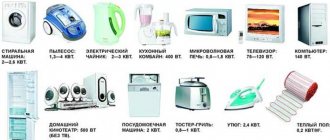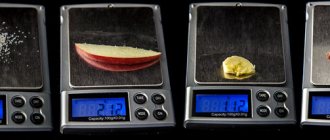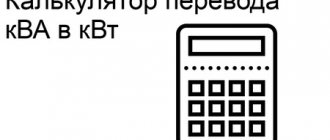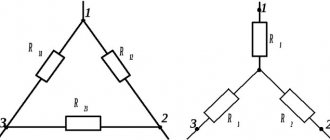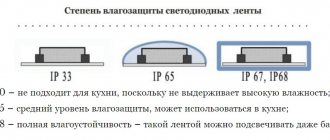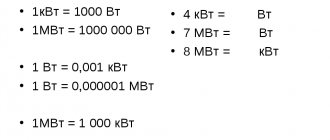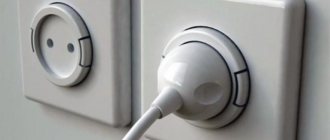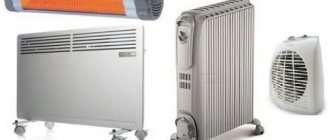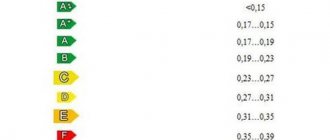Watt and kilowatt - what is it?
A watt is a unit of measurement of power, as well as heat flux in physics, sound electrical flux, direct electric current power, active and apparent electric current power, radiation flux and ionizing radiation energy flux in the international measurement system. It should be noted that this is a scalar measurable quantity, that is, measured and calculated.
Description from link
To make the use of watts convenient, the international system has adopted the use of prefixes that define a decimal multiple of the original indicator. Typically one kilowatt is used for this. Translated from Greek, the prefix kilogram means thousand. Using a prefix means increasing the original value by 103 times.
Note! KWh is a non-systemic unit of measurement that shows when energy is produced or consumed and in what quantity. It also shows the mechanical work performed and the temperature. Used to measure household electricity consumption or to measure electricity production in the energy sector.
How to correctly convert these units
A watt is equal to a kilogram per square meter divided by cubic seconds. The prefix kilo means multiply by 1000. The same principle applies to power indicators, that is, 1 kW equals 1000 watts and 1000 volts. This means that 1 unit = 0.001 subunits. That is, if you make a power transfer, a 3 kW electrical appliance will be equal to 3000 W.
You will be wondering what power the 16a machine is designed for
Conversion formula
In electricity
To simplify measurements in electricity, a subblock is used. You can find out how many watts are in kilowatts and convert the units by multiplying watts by 103 and dividing by 1000. To do the reverse conversion, you need to multiply kilowatts by 103 or multiply the known values by 1000.
Amount in electricity
In heating
Joules must be used to measure thermal power. This is the work done by 1 newton per 1 meter. To convert joules to kilowatts, you need to use the joules subunit. 1 kJ contains 0.239 kcal. There are 4.1868 kJ in 1 kcal. 1 kW contains 860 kcal. This means that 1000 kcal is 1163 kW per hour.
Thermal measures
Voltage 380 volts
Calculations for a three-phase network are carried out using a different formula. The voltage in such rooms is 380 V, it is distributed over three wires. Therefore, it is possible to install an automatic shutdown device with a lower rating at the same power consumption. The formula looks like this: P = U x I x root of 3. This way you can find out how many watts are in 1 ampere. To determine the number of kW, you need W x (0.7 x 380).
In a similar way, calculations can be carried out for a two-phase network. Its voltage is 266 V. One kilowatt will contain 3.7 A (1000/266). Accordingly, one ampere is equal to 266 watts. For a room with a two-phase network and a power consumption of 250 watts, a machine with a rating of 3.7 amperes is suitable. When choosing a device, you need to take into account the current strength, which is less in a three-phase network for the same amount of power consumption.
https://youtube.com/watch?v=7ZOXnl2rdM4
Converter
You can use an easy to use converter to calculate the values. A converter is a system that converts source data into a given value. All that is required from the user is to enter existing data in the field and click the start button on the service being used.
Note! There are various system converters. Some convert these watts, others directly into kilowatts.
Convector
Conversion table for watt to kilowatt
The measurement values presented in the table below will help you calculate the energy used by a particular device and perform other mathematical calculations in electrical engineering.
Table
In general, kilowatt is a subset of watt, a symbol representing power. You can correctly convert Watts to kW into electricity and heat using the conversion formula, table and special online calculator.
The difference between kilowatt and kilowatt∙hour
In electrical engineering there is a quantity called kilowatt-hour, which is measured by electric meters. Many people substitute concepts, not seeing the difference between the definitions of “kilowatt” and “kilowatt ∙ hour”, considering the values as a parameter.
Despite the similarity of names, these are completely different values. Kilowatt ∙ hour is used to measure the amount of electricity produced or consumed per unit of time. Specifically, the electricity consumption of a 1 kW ∙ hour user indicates the energy consumed by a 1 kW user in 1 hour. Conversely, a kilowatt is a unit of power that indicates the rate at which electricity is produced or consumed.
Example: A recessed LED luminaire is equipped with a 35W LED lamp. For 1 hour of operation it consumes 35 W ∙ hour of electricity, for 2 hours, respectively, 2x35 = 70 W ∙ hour. With continuous operation for 5 days / 120 hours, the power consumption of the lamp will be 35×120 = 4200 W ∙ hour or 4.2 kW ∙ hour.
Relation to base and multiple units of power
Watt refers to a derived unit of power, so in practice it is sometimes necessary to determine the value of a parameter in relation to the basic units of the international SI system. In technical calculations, the following correspondences to the basic values are used:
- W = kgm²/s³;
- L = Hm/s;
- W=VA
The parameter has universal application and is equally used in technical developments in various fields of activity.
Thermal engineering uses non-SI units to measure heat output in 1 cal/hour. Our considered value is related to it by the ratio: 1 W = 859.85 cal/hour.
Often, for the convenience of working with large power values of power plants and power groups, the word watt can be used with the prefixes “mega” or “giga”:
- megawatt is designated MW/MW and corresponds to 106 W;
- gigawatt (abbreviated GW/GW) is equal to 109 watts.
On the contrary, in low-current information networks, electronic devices and modern electronic equipment, power is measured in fractions of watts:
- milliwatts (mW, mW) – 10-3 W;
- microwatts (μW, μW) are equal to 10-6 W.
Using these ratios, it is always possible to convert most parameters into the required power units.
Wattmeter device
The power of household appliances simultaneously connected to the AC network should not exceed the permissible power of the network. Failure to comply with this condition can lead to overheating of the electrical wiring, failure of technical equipment, short circuit and fire in the room.
Power is determined using a special measuring device - a wattmeter. This device helps:
- control the operation of equipment,
- carry out testing of installations,
- keep track of energy consumption.
In a DC circuit, power is the product of current in amperes and voltage in volts, so no special equipment is required to determine this value.
In an alternating current circuit, power depends on three indicators: voltage, current and the phase shift between them. Therefore, wattmeters are used to determine power in AC networks.
Wattmeters are either analog or digital. Analog instruments can be recording or indicating. The indicator of the indicating wattmeter consists of a semicircular scale and a rotating arrow. The scale is calibrated according to power values in W. The operation of the device is based on the interaction of two inductors. The first, fixedly fixed, with a thick winding, a small number of turns and low resistance. This coil (1) is connected in series with the load (N). The second inductor is movable, with a large number of turns, made of thin copper conductor and high resistance. In the circuit, the coil (2) is connected in parallel to the load (H) together with an additional resistor (R) to prevent a short circuit between the inductances.
When taking measurements, the coils generate magnetic fields, the interaction of which leads to the formation of torque. The moving coil with the arrow deviates at a certain angle. The angle is equal to the product of current and voltage at the current time.
Wattmeter device diagram
Digital wattmeters determine reactive and active power. In addition, the digital screen of the device displays readings of voltage, current, and energy consumption per unit of time.
The operation of a digital wattmeter is based on a preliminary measurement of voltage and current. To do this, a current sensor is installed at the input of the device in series with the load, and a voltage sensor in parallel. The resulting instantaneous values are transmitted to the microcontroller, where the active and reactive components are calculated. The result is displayed on the display or attached external devices.
How to calculate the total power of household appliances
The installed power of a house or cottage is important when calculating and choosing electrical wiring and machines. Without this parameter it is impossible to design the power supply of the house.
To find out the installed power, you need to select energy consumption data from the equipment data sheets. For example, as indicated on the license plate.
| Name | Power, W |
| A television | 150 |
| Water heater | 1,500 |
| Electric oven | 2 000 |
| Fixtures (total number of light bulbs throughout the house) | 1,000 |
| Computer | 100 |
| GENERAL: | 3.750 W or 3.75 kW |
To correctly calculate the power supply to a home, the combination coefficient is taken into account. Indicates how many consumers are running at the same time.
For installed power in a house, cottage, apartment up to 14 kW, a coefficient of 0.8 is used in the calculations. That is, the total value of the loads is taken and multiplied by 0.8. For our example, the calculations require a power of 3.75 * 0.8 = 3 kW.
Example
To convert the specified parameters of an electrical device from kW to W, it is necessary to clarify the information from the markings on the product body, or obtain data from the equipment passport developed by the manufacturer and included in the product package.
If it is determined that the power rating of an electric kettle is 2.2 kW, this means that in watts this value will be 2.2 x 1000 = 2200 W.
In some situations, it is necessary to determine the value of the total power characteristics of household consuming devices. This need may arise in the following cases:
- to select a sufficient cable diameter when installing electrical wiring;
- when choosing safety devices that disconnect the network if the parameters exceed permissible values;
- to ensure the correct layout of household equipment in the house and proper wiring.
The calculation is performed by summing the above indicators for each of the devices. After this, the obtained value is compared with that indicated as a control value in the characteristics of the cable or safety devices, and is taken into account when locating the equipment.
For the calculation to be correct, all values must first be converted into common units of measurement from watts to kilowatts or vice versa, using the previously described method.
Converting watts to kW
For example, the iron says 2000 watts (W), this means 2 kW, another example with a 100 W light bulb, when converted to kW we get 0.1 kW, so:
1 kW = 1000 W
By analogy, other meanings can be translated:
You can also convert 1, 2, 3, 4, 5, 6, 7, 8 kW, etc. In watts:
Power (W) Power (kW)
| 1000 | 1 |
| 2000 g | 2 |
| 3000 | 3 |
| 4000 | 4 |
| 5000 | 5 |
| 6000 | 6 |
| 7000 | 7 |
| 8000 | eight |
Calculation
Special formulas are used to calculate values. After counting them, all that remains is to insert them into the above formulas. To find the electric current, you need to divide the voltage by the conductor resistance, and to find the power, you need to multiply the voltage by the current force or double the current value by the resistance. It is also possible to divide the double voltage value by the resistance.
Note! Often all the necessary data is written on the box or technical specifications on the manufacturer’s website. Often the information is indicated in kW and can easily be converted to amperage using a converter
Another easy way to determine energy consumption and amperage is to examine the consumer's electric meter or circuit breaker. But in this case, it is necessary to connect only one device to the network.
Calculation formula


